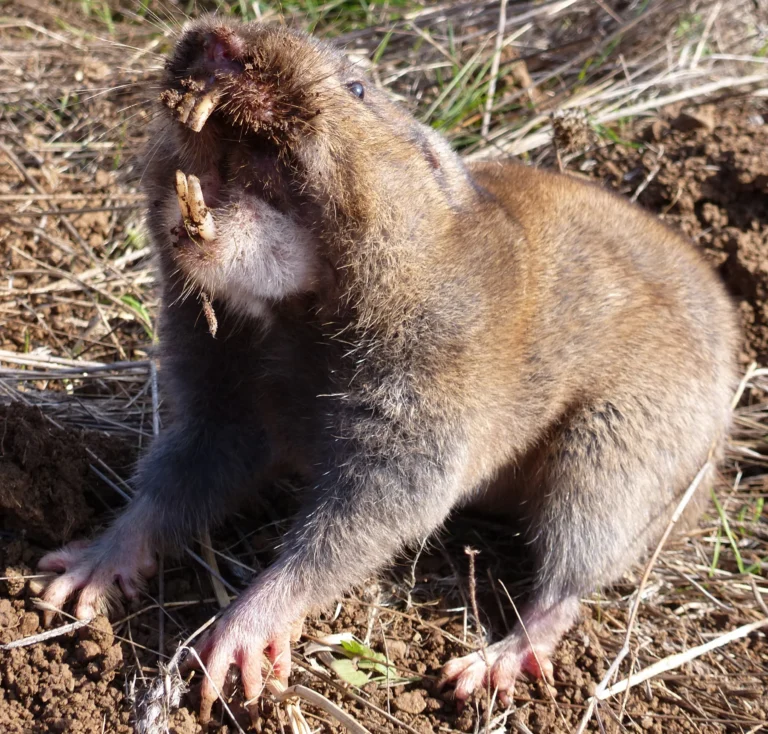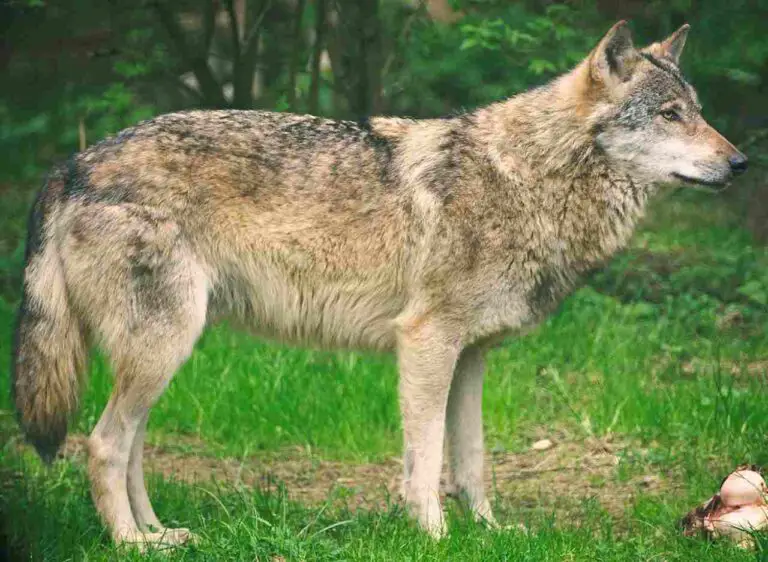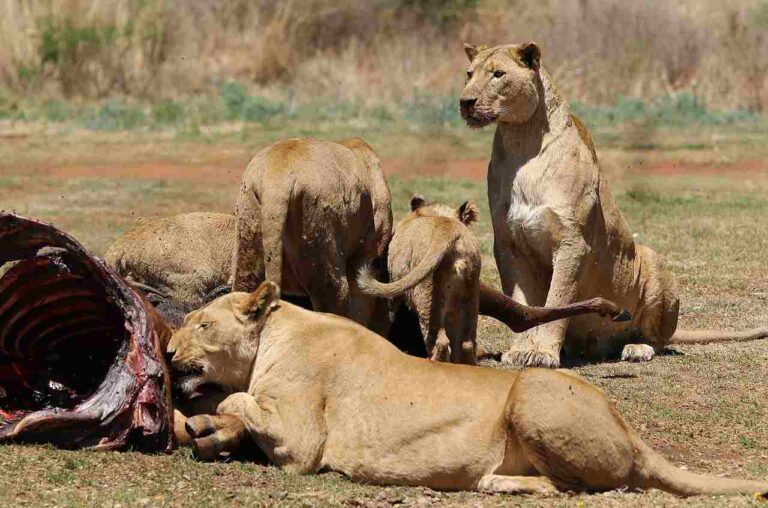Great Plains Rat Snake Characteristics, Face, Description
The Great Plains rat snake (Pantherophis emoryi) is a non-venomous species native to the central United States, known for its slender body, tan or gray coloration with brown blotches, and relatively docile nature. They primarily feed on rodents and birds, playing a role in controlling populations of agricultural pests. While generally of Least Concern in terms of conservation status, localized threats such as habitat loss and persecution highlight the importance of conservation efforts. Additionally, while occasionally kept as pets, responsible ownership practices are crucial to prevent negative impacts on native ecosystems.
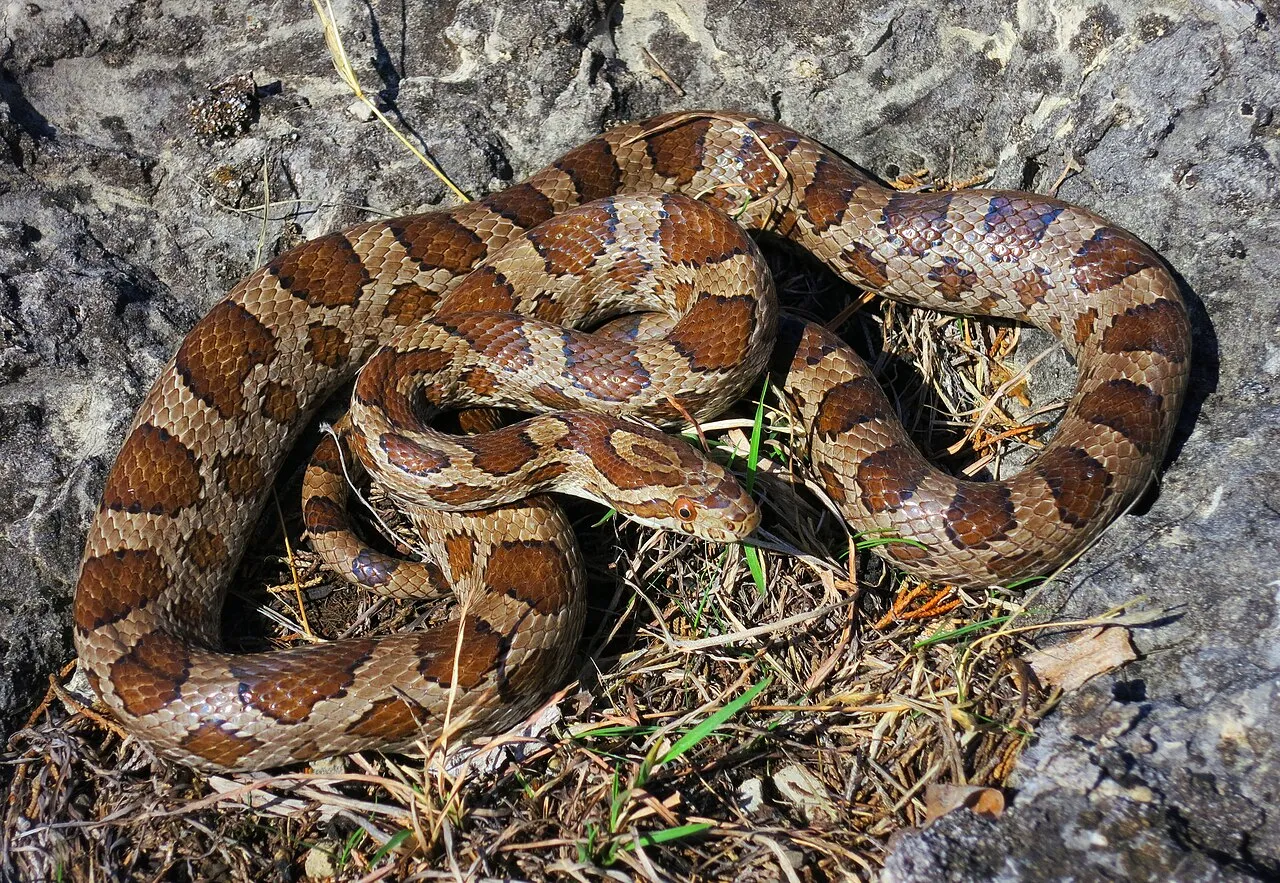
*Facts About Great Plains Rat Snake
| Criteria | Summary |
| Scientific Classification |
Pantherophis emoryi; Kingdom: Animalia, Phylum: Chordata, Class: Reptilia, Order: Squamata, Family: Colubridae, Genus: Pantherophis, Species: emoryi
|
| Subspecies |
Two recognized: P. e. emoryi and P. e. meahllmorum; Aids in understanding genetic diversity and geographic variations within the species.
|
| Size and Weight |
Length: 36 to 72 inches, Weight: 500 to 1,000 grams; Important for population identification, estimating ecological impacts, and understanding prey preferences.
|
| Appearance and Identification |
Slender body with tan or gray coloration and brown blotches; Facilitates species identification and understanding of camouflage strategies.
|
| Dentition and Bite Force |
Non-venomous with numerous small teeth and low bite force; Reduces risk to humans, influences prey capture strategies.
|
| Venomous Potency |
Non-venomous; relies on constriction; Lowers threat to humans and other animals.
|
| Diet |
Primarily feeds on rodents, birds, and bird eggs; Helps control populations of agricultural pests, maintains ecosystem balance.
|
| Behavior |
Terrestrial, diurnal, occasionally nocturnal, capable climbers; Influences foraging strategies, habitat utilization, and responses to environmental changes.
|
| Sounds/Vocalization |
Limited vocalization; may hiss when threatened; Affects predator-prey interactions and intra-species communication.
|
| Habitat |
Inhabits grasslands, prairies, scrublands, and woodland edges; Understanding habitat preferences aids in conservation planning.
|
| Geographic Range and Distribution |
Native to central United States; Helps assess population trends and conservation priorities.
|
| Reproduction |
Oviparous, mating in spring, females lay clutches of eggs in late spring or early summer; Reproductive biology influences population dynamics and genetic diversity.
|
| Lifespan |
Average lifespan of 10 to 15 years in the wild; Affects population dynamics and ecological stability.
|
| Major Adaptations |
Camouflage, efficient hunting techniques, and non-venomous bite; Enhances survival in diverse habitats and ecological niches.
|
| Conservation Status |
Generally of Least Concern but faces localized threats from habitat loss and persecution; Helps prioritize conservation efforts.
|
| Domestication and Suitability as a Pet |
Occasionally kept as pets due to docile nature and ease of care; Responsible pet ownership practices crucial to prevent negative impacts on native ecosystems.
|
1. Scientific Classification:
Kingdom: Animalia
Phylum: Chordata
Class: Reptilia
Order: Squamata
Family: Colubridae
Genus: Pantherophis
Species: Pantherophis emoryi
2. Subspecies:
Details: The Great Plains rat snake (Pantherophis emoryi) has two recognized subspecies: P. e. emoryi and P. e. meahllmorum.
Importance: Subspecies classification helps in understanding the genetic diversity and geographic variations within the species.
Ecological Implications: Differences between subspecies may indicate adaptations to specific habitats or environmental conditions, aiding in conservation efforts and ecosystem management.
3. Size and Weight:
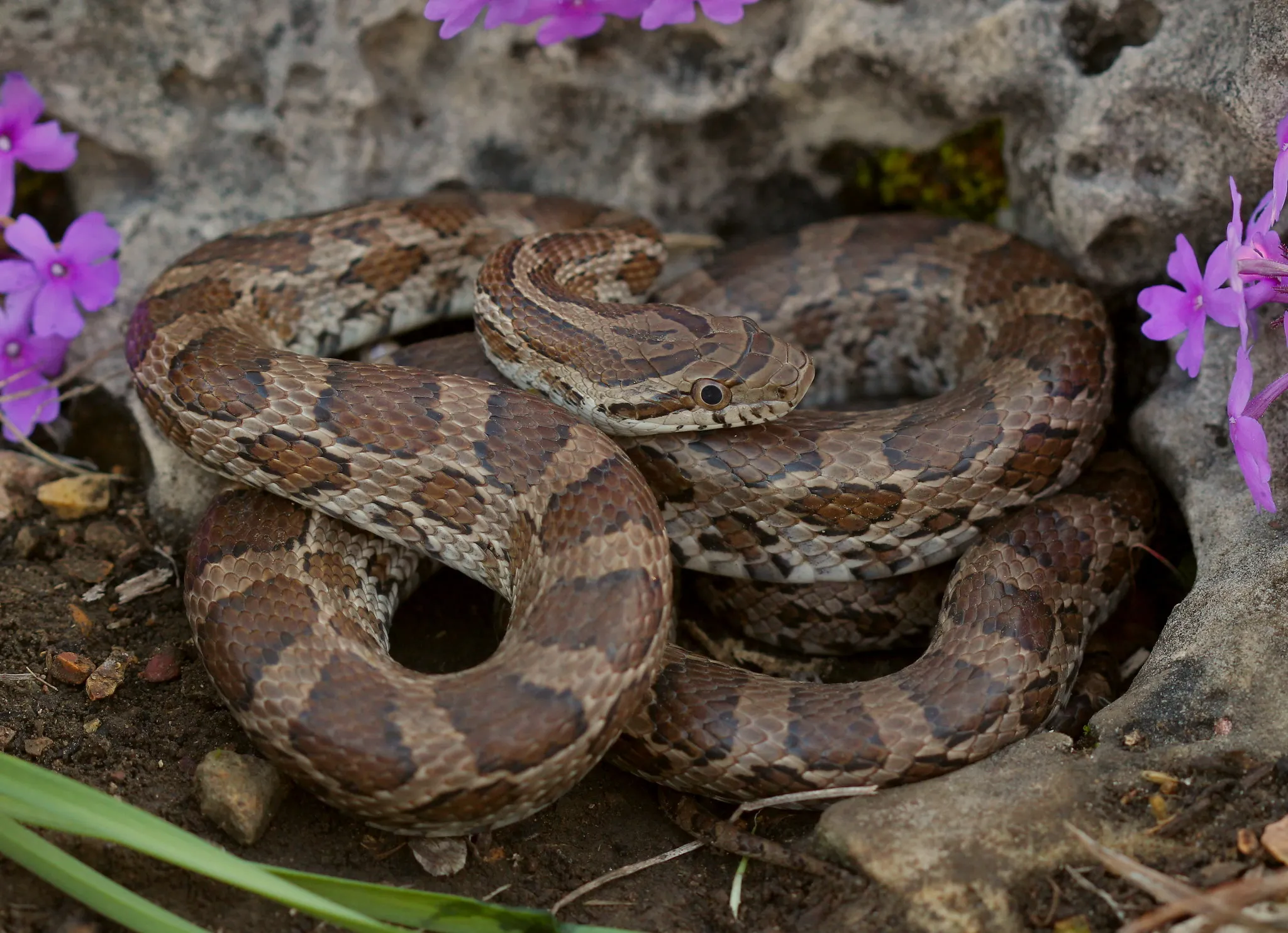
Details: Great Plains rat snakes typically measure between 36 to 72 inches (91 to 183 cm) in length and weigh around 500 to 1,000 grams.
Importance: Understanding their size and weight helps in identifying and managing populations, assessing prey preferences, and estimating ecological impacts.
Ecological Implications: Size influences their role in the ecosystem as predators, affecting prey selection and population dynamics of their prey species.
4. Appearance and Identification:
Details: Great Plains rat snakes have a slender body with smooth scales. They are typically tan or gray with brown blotches along their back and sides, with a lighter belly.
Importance: Appearance aids in species identification and differentiation from other snake species.
Ecological Implications: Camouflage and coloration play a role in predator avoidance and prey detection, impacting their survival and ecological interactions.
5. Dentition and Bite Force:
Details: Great Plains rat snakes have numerous small teeth, angled backwards to aid in gripping and swallowing prey. Bite force varies but is relatively low compared to venomous snakes.
Importance: Dentition and bite force influence prey capture and handling strategies.
Ecological Implications: Their non-venomous nature and relatively mild bite make them less of a threat to humans, reducing conflicts and facilitating coexistence in shared habitats.
6. Venomous Potency:
Details: Great Plains rat snakes are non-venomous and rely on constriction to subdue their prey.
Importance: Lack of venom reduces the risk to humans and other animals, making encounters with these snakes generally harmless.
Ecological Implications: Their non-venomous nature allows them to coexist with a variety of prey species without posing a significant threat to ecosystem dynamics.
7. Diet:
Details: Great Plains rat snakes primarily feed on rodents, birds, bird eggs, and occasionally other small vertebrates.
Importance: Their role as rodent predators can help control populations of agricultural pests and maintain ecosystem balance.
Ecological Implications: By regulating rodent populations, they indirectly impact vegetation dynamics and the abundance of other animal species that share the same habitat.
8. Behavior:
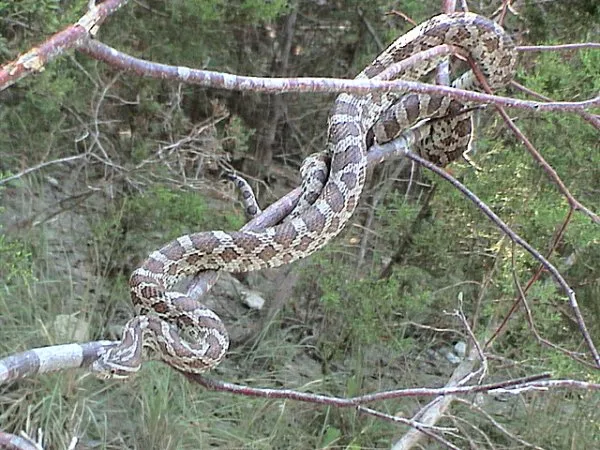
Details: Great Plains rat snakes are primarily terrestrial but are also capable climbers. They are active mainly during the day (diurnal) and become more nocturnal during hot weather.
Importance: Understanding their behavior aids in predicting their movements, habitat preferences, and interactions with other species.
Ecological Implications: Behavioral patterns influence their foraging strategies, habitat utilization, and responses to environmental changes, which in turn affect their role in the ecosystem.
9. Sounds/Vocalization:
Details: Great Plains rat snakes are not known for vocalization but may hiss when threatened or disturbed.
Importance: Limited vocalization suggests reliance on other forms of communication or behavioral cues.
Ecological Implications: Vocalizations or lack thereof can affect predator-prey interactions, intra-species communication, and territorial behavior within their ecological community.
10. Habitat:
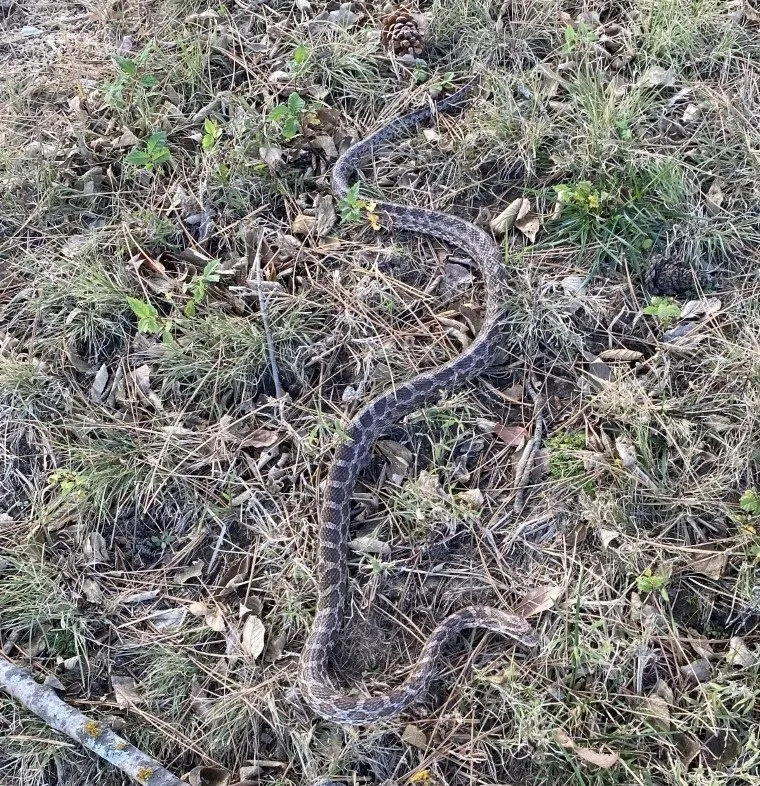
Details: Great Plains rat snakes inhabit a variety of habitats including grasslands, prairies, scrublands, agricultural fields, and woodland edges. They prefer areas with ample cover such as rocks, logs, and vegetation.
Importance: Understanding habitat preferences helps in identifying suitable conservation areas and managing human activities that may impact their habitat.
Ecological Implications: Their habitat selection influences their prey availability, predator avoidance strategies, and overall population dynamics within the ecosystem.
11. Geographic Range and Distribution:
Details: Great Plains rat snakes are native to the central United States, primarily found in states such as Texas, Oklahoma, Kansas, Nebraska, and parts of surrounding states.
Importance: Knowing their geographic range helps in assessing population trends, habitat connectivity, and conservation priorities.
Ecological Implications: Their distribution affects interactions with other species, gene flow between populations, and vulnerability to habitat fragmentation or climate change.
12. Reproduction:
Details: Great Plains rat snakes are oviparous, meaning they lay eggs. Mating typically occurs in the spring, with females laying clutches of 6 to 24 eggs in late spring or early summer.
Importance: Understanding reproductive biology aids in population monitoring, assessing reproductive success, and implementing conservation strategies.
Ecological Implications: Reproductive patterns influence population dynamics, genetic diversity, and resilience to environmental changes within their habitat.
13. Lifespan:
Details: Great Plains rat snakes have an average lifespan of around 10 to 15 years in the wild, although they can live longer in captivity with proper care.
Importance: Lifespan affects population dynamics, reproductive potential, and resilience to environmental pressures.
Ecological Implications: Longevity impacts their role in ecosystem dynamics, predator-prey relationships, and overall ecological stability over time.
14. Major Adaptations:
Details: Great Plains rat snakes have evolved several adaptations for survival, including camouflage for predator avoidance, efficient hunting techniques such as constriction, and a non-venomous bite for prey capture.
Importance: These adaptations enhance their ability to thrive in various habitats and ecological niches.
Ecological Implications: Adaptations influence their interactions with other species, population dynamics, and ecosystem processes.
15. Conservation Status:
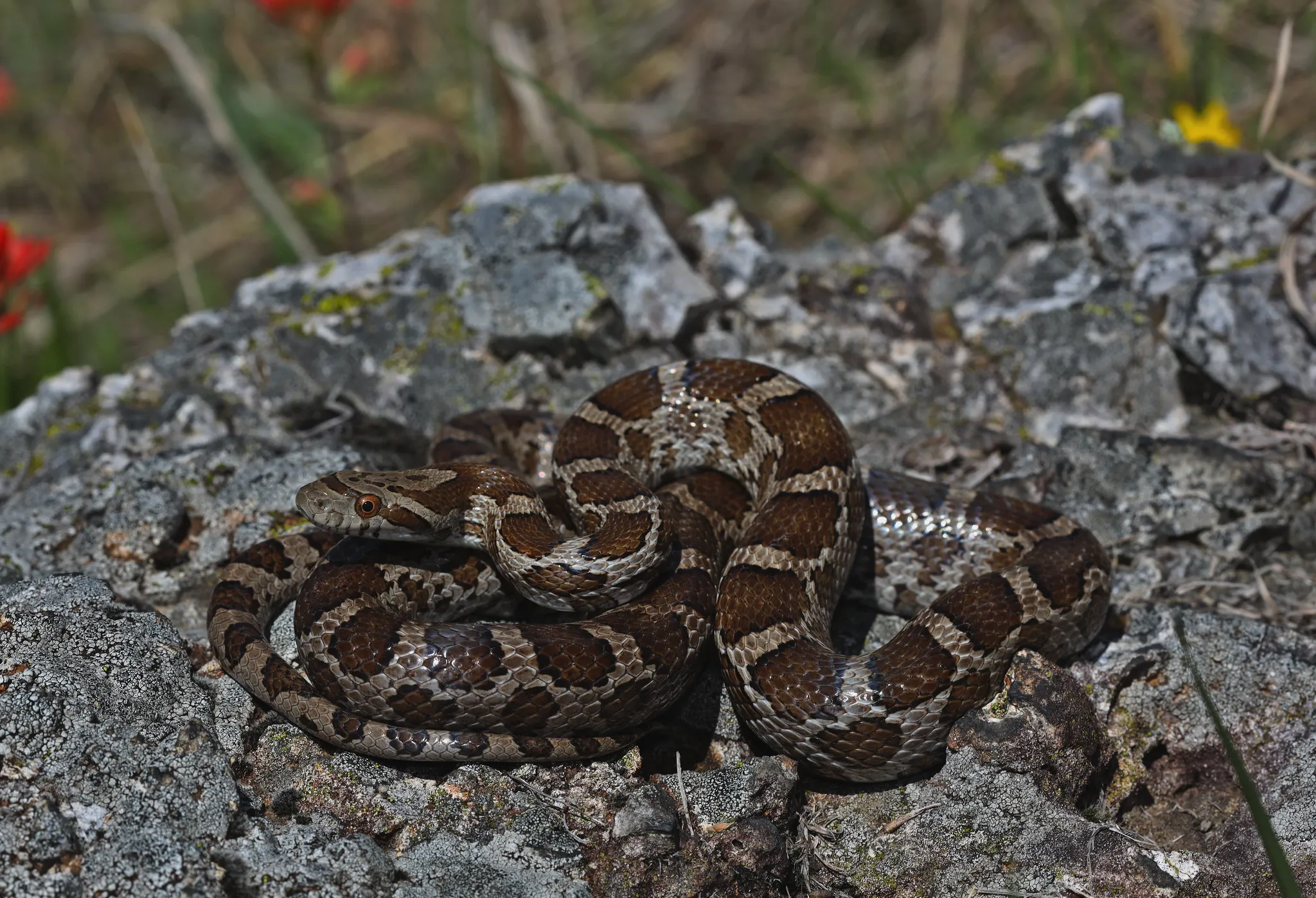
Details: The Great Plains rat snake is generally considered to be of Least Concern according to the IUCN Red List. However, habitat loss, fragmentation, and persecution by humans pose localized threats to some populations.
Importance: Assessing conservation status helps prioritize conservation efforts and implement measures to mitigate threats.
Ecological Implications: Conservation status reflects the health of ecosystems and the effectiveness of conservation strategies in preserving biodiversity.
16. Domestication and Suitability as a Pet:
Details: Great Plains rat snakes are occasionally kept as pets due to their relatively docile nature, ease of care, and attractive appearance.
Importance: Understanding their suitability as pets informs responsible pet ownership practices and helps prevent illegal trade or collection from the wild.
Ecological Implications: While captive breeding reduces pressure on wild populations, improper care or release of pet snakes into the wild can negatively impact native ecosystems through competition, predation, or disease transmission.
*Summary of Information On Great Plains Rat Snakes
Scientific Classification:
Kingdom: Animalia
Phylum: Chordata
Class: Reptilia
Order: Squamata
Family: Colubridae
Genus: Pantherophis
Species: Pantherophis emoryi
Subspecies:
Two recognized subspecies: P. e. emoryi and P. e. meahllmorum
Importance: Provides insights into genetic diversity and geographic variations within the species, aiding conservation efforts.
Size and Weight:
Length: 36 to 72 inches (91 to 183 cm)
Weight: Approximately 500 to 1,000 grams
Importance: Helps in population identification, estimating ecological impacts, and understanding prey preferences.
Appearance and Identification:
Slender body with tan or gray coloration and brown blotches.
Importance: Facilitates species identification and understanding of camouflage strategies.
Dentition and Bite Force:
Non-venomous with numerous small teeth and low bite force.
Importance: Reduces risk to humans, influences prey capture strategies.
Non-venomous; relies on constriction to subdue prey.
Importance: Lowers threat to humans and other animals.
Diet:
Primarily feeds on rodents, birds, and bird eggs.
Importance: Helps control populations of agricultural pests, maintains ecosystem balance.
Behavior:
Terrestrial, diurnal, and occasionally nocturnal; capable climbers.
Importance: Influences foraging strategies, habitat utilization, and responses to environmental changes.
Sounds/Vocalization:
Limited vocalization; may hiss when threatened.
Importance: Affects predator-prey interactions and intra-species communication.
Habitat:
Inhabits grasslands, prairies, scrublands, and woodland edges.
Importance: Understanding habitat preferences aids in conservation planning and management.
Geographic Range and Distribution:
Native to central United States, including Texas, Oklahoma, Kansas, Nebraska, and surrounding states.
Importance: Helps assess population trends and conservation priorities.
Reproduction:
Oviparous, mating occurs in spring, females lay clutches of eggs in late spring or early summer.
Importance: Reproductive biology influences population dynamics and genetic diversity.
Lifespan:
Average lifespan of 10 to 15 years in the wild.
Importance: Lifespan affects population dynamics and ecological stability.
Major Adaptations:
Camouflage, efficient hunting techniques, and non-venomous bite.
Importance: Enhances survival in diverse habitats and ecological niches.
Conservation Status:
Generally of Least Concern but faces localized threats from habitat loss and persecution.
Importance: Helps prioritize conservation efforts and mitigate threats.
Domestication and Suitability as a Pet:
Occasionally kept as pets due to docile nature and ease of care.
Importance: Responsible pet ownership practices are crucial to prevent negative impacts on native ecosystems.


